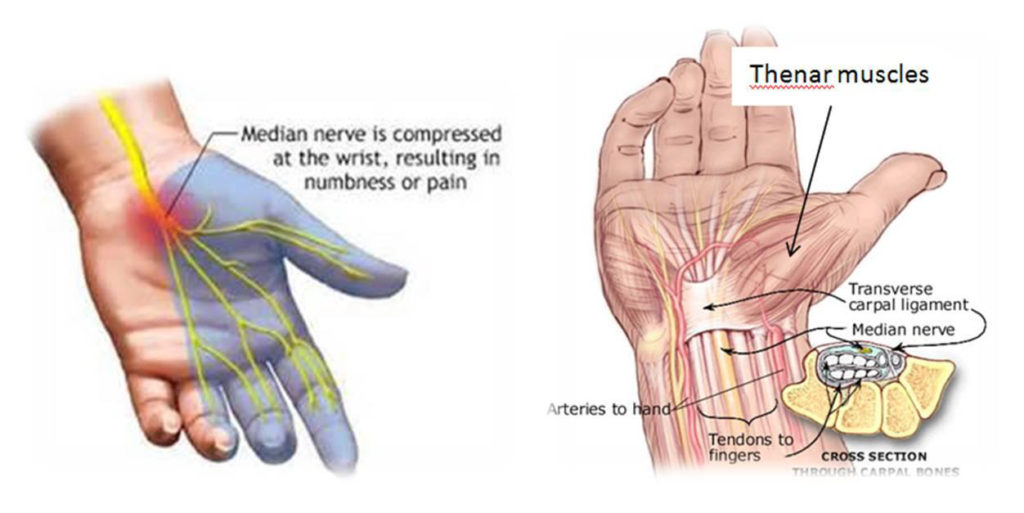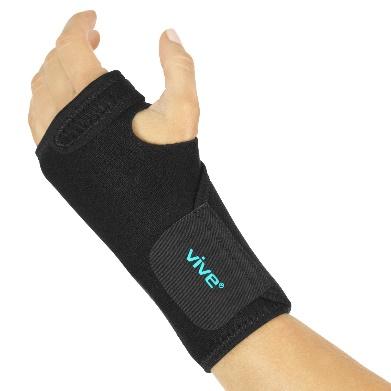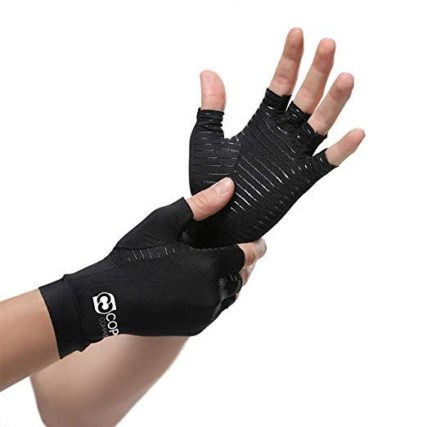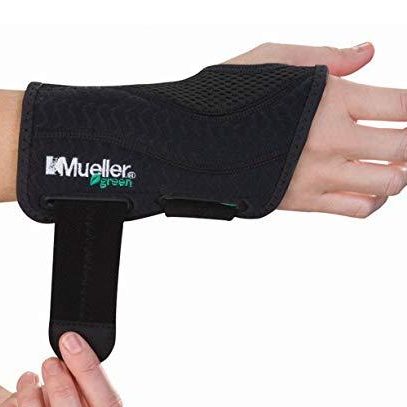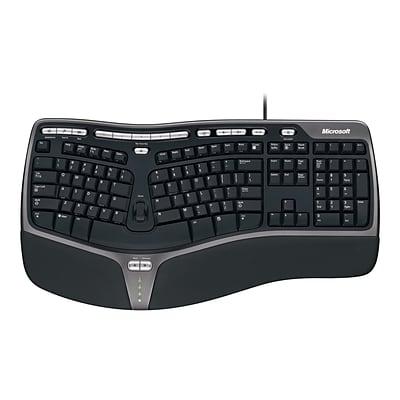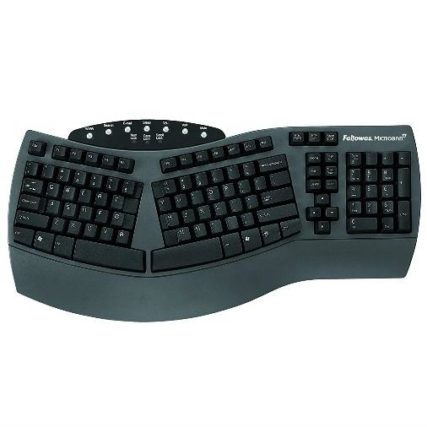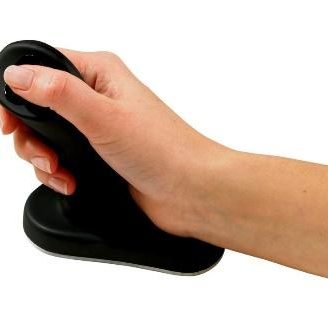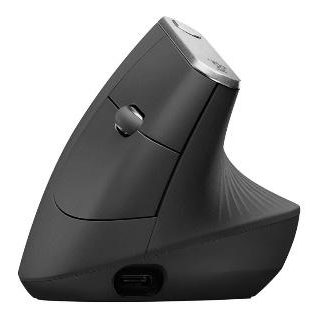Carpal Tunnel Syndrome
You’re working at your desk in Irvine, Anaheim or Costa Mesa, trying to ignore the tingling or numbness you’ve had for months in your hand and wrist. Suddenly, a sharp, piercing pain shoots through the wrist and up your arm. Just a passing cramp? More likely you have carpal tunnel syndrome, a painful progressive condition caused by compression of a key nerve in the wrist.
Although it might seem that carpal tunnel syndrome is a condition born from long hours spent working on a computer keyboard, carpal tunnel syndrome actually has numerous causes.
Bound by bones and ligaments, the carpal tunnel is a narrow passageway – about the diameter of your thumb — located on the palm side of your wrist. This tunnel protects a main nerve to your hand and nine tendons that bend your fingers. Pressure placed on the nerve produces the numbness, pain and, eventually, hand weakness that characterize carpal tunnel syndrome.
Fortunately, for most people who develop carpal tunnel syndrome, proper treatment usually can relieve the pain and numbness and restore normal use of their wrists and hands.
What is carpal tunnel syndrome?
Carpal tunnel syndrome occurs when the median nerve, which runs from the forearm into the hand, becomes pressed or squeezed at the wrist. The median nerve controls sensations to the palm side of the thumb and fingers (although not the little finger), as well as impulses to some small muscles in the hand that allow the fingers and thumb to move. The carpal tunnel – a narrow, rigid passageway of ligament and bones at the base of the hand – houses the median nerve and tendons. Sometimes, thickening from irritated tendons or other swelling narrows the tunnel and causes the median nerve to be compressed. The result may be pain, weakness, or numbness in the hand and wrist, radiating up the arm. Although painful sensations may indicate other conditions, carpal tunnel syndrome is the most common and widely known of the entrapment neuropathies in which the body’s peripheral nerves are compressed or traumatized.
What are the symptoms of carpal tunnel syndrome?
Symptoms usually start gradually, with frequent burning, tingling, or itching numbness in the palm of the hand and the fingers, especially the thumb, index and middle fingers. Some carpal tunnel sufferers say their fingers feel useless and swollen, even though little or no swelling is apparent. The symptoms often first appear in one or both hands during the night, since many people sleep with flexed wrists. A person with carpal tunnel syndrome may wake up feeling the need to “shake out” the hand or wrist. As symptoms worsen, people might feel tingling during the day. Decreased grip strength may make it difficult to form a fist, grasp small objects, or perform other manual tasks. In chronic and/or untreated cases, the muscles at the base of the thumb may waste away. Some people are unable to tell the difference between hot and cold by touch.
What are the causes of carpal tunnel syndrome?
Carpal tunnel syndrome is often the result of a combination of factors that increase pressure on the median nerve and tendons in the carpal tunnel, rather than a problem with the nerve itself. Most likely the disorder is due to a congenital predisposition – the carpal tunnel is simply smaller in some people than in others. Other contributing factors include trauma or injury to the wrist that cause swelling, such as sprain or fracture; over activity of the pituitary gland; hypothyroidism; rheumatoid arthritis; mechanical problems in the wrist joint; work stress; repeated use of vibrating hand tools; fluid retention during pregnancy or menopause; or the development of a cyst or tumor in the canal. In some cases, no cause can be identified.
There is little clinical data to prove whether repetitive and forceful movements of the hand and wrist during work or leisure activities can cause carpal tunnel syndrome. Repeated motions performed in the course of normal work or other daily activities can result in repetitive motion disorders such as bursitis and tendonitis. Writer’s cramp – a condition in which a lack of fine motor skill coordination and ache and pressure in the fingers, wrist, or forearm is brought on by repetitive activity – is not a symptom of carpal tunnel syndrome.
Who is at risk of developing carpal tunnel syndrome?
Women are three times more likely than men to develop carpal tunnel syndrome, perhaps because the carpal tunnel itself may be smaller in women than in men. The dominant hand is usually affected first and produces the most severe pain. Persons with diabetes or other metabolic disorders that directly affect the body’s nerves and make them more susceptible to compression are also at high risk. Carpal tunnel syndrome usually occurs only in adults.
The risk of developing carpal tunnel syndrome is not confined to people in a single industry or job, but is especially common in those performing assembly line work – manufacturing, sewing, finishing, cleaning, and meat, poultry, or fish packing. In fact, carpal tunnel syndrome is three times more common among assemblers than among data-entry personnel. A 2001 study by the Mayo Clinic found heavy computer use (up to 7 hours a day) did not increase a person’s risk of developing carpal tunnel syndrome.
During 1998, an estimated three of every 10,000 workers lost time from work because of carpal tunnel syndrome. Half of these workers missed more than 10 days of work per year. The average lifetime cost of carpal tunnel syndrome, including medical bills and lost time from work, is estimated to be about $30,000 for each injured worker.
How is carpal tunnel syndrome diagnosed?
Early diagnosis and treatment are important to avoid permanent damage to the median nerve. A physical examination of the hands, arms, shoulders, and neck can help determine if the patient’s complaints are related to daily activities or to an underlying disorder and can rule out other painful conditions that mimic carpal tunnel syndrome. The wrist is examined for tenderness, swelling, warmth, and discoloration. Each finger should be tested for sensation, and the muscles at the base of the hand should be examined for strength and signs of atrophy. Routine laboratory tests and X-rays can reveal diabetes, arthritis, and fractures.
Physicians can use specific tests to try to produce the symptoms of carpal tunnel syndrome. In the Tinel test, the doctor taps on or presses on the median nerve in the patient’s wrist. The test is positive when tingling in the fingers or a resultant shock-like sensation occurs. The Phalen, or wrist-flexion, test involves having the patient hold his or her forearms upright by pointing the fingers down and pressing the backs of the hands together. The presence of carpal tunnel syndrome is suggested if one or more symptoms, such as tingling or increasing numbness, is felt in the fingers within 1 minute. Doctors may also ask patients to try to make a movement that brings on symptoms.
Often it is necessary to confirm the diagnosis by the use of electro diagnostic tests. In a nerve conduction study, electrodes are placed on the hand and wrist. Small electric shocks are applied and the speed with which nerves transmit impulses is measured. In electromyography, a fine needle is inserted into a muscle; electrical activity viewed on a screen can determine the severity of damage to the median nerve. Ultrasound imaging can show impaired movement of the median nerve. Magnetic resonance imaging (MRI) can show the anatomy of the wrist but to date has not been especially useful in diagnosing carpal tunnel syndrome.
How is carpal tunnel syndrome treated?
Treatments for carpal tunnel syndrome should begin as early as possible, under a doctor’s direction. Underlying causes such as diabetes or arthritis should be treated first. Initial treatment generally involves resting the affected hand and wrist for at least 2 weeks, avoiding activities that may worsen symptoms, and immobilizing the wrist in a splint to avoid further damage from twisting or bending. If there is inflammation, applying cool packs can help reduce swelling.
- Drugs
In special circumstances, various drugs can ease the pain and swelling associated with carpal tunnel syndrome. Nonsteroidal anti-inflammatory drugs, such as aspirin, ibuprofen, and other nonprescription pain relievers, may ease symptoms that have been present for a short time or have been caused by strenuous activity. Orally administered diuretics (“water pills”) can decrease swelling. Corticosteroids (such as prednisone) or the drug lidocaine can be injected directly into the wrist or taken by mouth (in the case of prednisone) to relieve pressure on the median nerve and provide immediate, temporary relief to persons with mild or intermittent symptoms. (Caution: persons with diabetes and those who may be predisposed to diabetes should note that prolonged use of corticosteroids can make it difficult to regulate insulin levels. Corticosteroids should not be taken without a doctor’s prescription.) Additionally, some studies show that vitamin B6 (pyridoxine) supplements may ease the symptoms of carpal tunnel syndrome. - Exercise
Stretching and strengthening exercises can be helpful in people whose symptoms have abated. These exercises may be supervised by a physical therapist, who is trained to use exercises to treat physical impairments, or an occupational therapist, who is trained in evaluating people with physical impairments and helping them build skills to improve their health and well-being. - Alternative Therapies
Acupuncture and chiropractic care have benefited some patients but their effectiveness remains unproved. An exception is yoga, which has been shown to reduce pain and improve grip strength among patients with carpal tunnel syndrome.
Carpal tunnel release is one of the most common surgical procedures in the United States. Generally recommended if symptoms last for 6 months, surgery involves severing the band of tissue around the wrist to reduce pressure on the median nerve. Surgery is done under local anesthesia and does not require an overnight hospital stay. Many patients require surgery on both hands. The following are types of carpal tunnel release surgery:
- Open Release Surgery
The traditional procedure used to correct carpal tunnel syndrome, consists of making an incision up to 2 inches in the wrist and then cutting the carpal ligament to enlarge the carpal tunnel. The procedure is generally done under local anesthesia on an outpatient basis, unless there are unusual medical considerations. - Endoscopic Surgery
May allow faster functional recovery and less postoperative discomfort than traditional open release surgery. The surgeon makes two incisions (about ½” each) in the wrist and palm, inserts a camera attached to a tube, observes the tissue on a screen, and cuts the carpal ligament (the tissue that holds joints together). This two-portal endoscopic surgery, generally performed under local anesthesia, is effective and minimizes scarring and scar tenderness, if any. One-portal endoscopic surgery for carpal tunnel syndrome is also available.
Although symptoms may be relieved immediately after surgery, full recovery from carpal tunnel surgery can take months. Some patients may have infection, nerve damage, stiffness, and pain at the scar. Occasionally the wrist loses strength because the carpal ligament is cut. Patients should undergo physical therapy after surgery to restore wrist strength. Some patients may need to adjust job duties or even change jobs after recovery from surgery.
Recurrence of carpal tunnel syndrome following treatment is rare. The majority of patients recover completely.
How Can Carpal Tunnel Syndrome be Prevented in an Office Environment?
Workers can do the following to help themselves
- On-the-job conditioning.
- Perform stretching exercises.
- Take frequent rest breaks.
- Wear splints to keep wrists straight.
- Use correct posture and wrist position.
- Wearing fingerless gloves can help keep hands warm and flexible.
- Workstations, tools and tool handles, and tasks can be redesigned to enable the worker’s wrist to maintain a natural position during work.
Employers can review Ergonomic Workplace Practices and Workplace Conditions to ensure that they match job demands to the capabilities of workers – such as:
Keyboard
Computer keyboard and mouse use are known to increase carpal tunnel load and cause deformation of the median nerve longitudinal axis. Several studies have reported that changes in wrist posture, finger movement, and contact stress can lead to an increase in carpal tunnel pressure. If the workstation is not set up properly, continuous computer work can expose soft tissues to repetitive stress, which could result in ergonomic injuries to the hand, wrist, forearm, elbow, and shoulder.
Mouse / Trackball / Touchpad
Proper placement is important. Place mouse (or trackball) adjacent to the keyboard and at the same height as the keyboard. Placing the mouse/trackball too far away, too low, or too far over to one side can cause wrist, forearm, elbow, and shoulder discomfort. Placing the pointing device in your immediate reach zone offers natural comfort and maximum hand-eye coordination. Always “test drive” the different pointing devices and choose the one that feels most naturally comfortable to you.
Mouse
- Using a mouse requires stability of the surface upon which it is placed; if used on a keyboard tray, the tray should not wobble or tip.
- Using a mouse without a mousepad will help prevent the wrist from being tilted upward and causing strain.
Trackball
- A trackball has an exposed ball that is manipulated with the fingers. It requires the use of different muscle and tendon groups than those used when operating a mouse.
- Some trackball designs may cause discomfort/injury to the area around the thumb, which stretches/reaches to maneuver the trackball.
Touchpad
- Allow users to move the cursor across the screen by moving the fingers across a small screen.
- They have no moving parts that can become clogged with dust, but they can lead to increased arm fatigue.
Ergonomic Work Practices / Habits
- A padded wrist rest placed before the keyboard is used only for resting the wrists when no data is actually being input.
- Press keys gently; do not bang on them or hold them down for long periods.
- Keep your shoulders, arms, hands and fingers relaxed.
Setting Up the Workstation
- Adjust your chair and posture for the least- stressful arm/wrist positioning.
- Adjust your chair so that the arms are bent at the elbow at a 90 angle; the forearms should be parallel to the floor.
- Adjust keyboard height and distance from the edge of the desk so that the shoulders can relax and allow arms to rest at sides.
- Adjust the slope of the keyboard so that the wrists are flat (i.e., in a neutral position) and not bent upward/back at all.
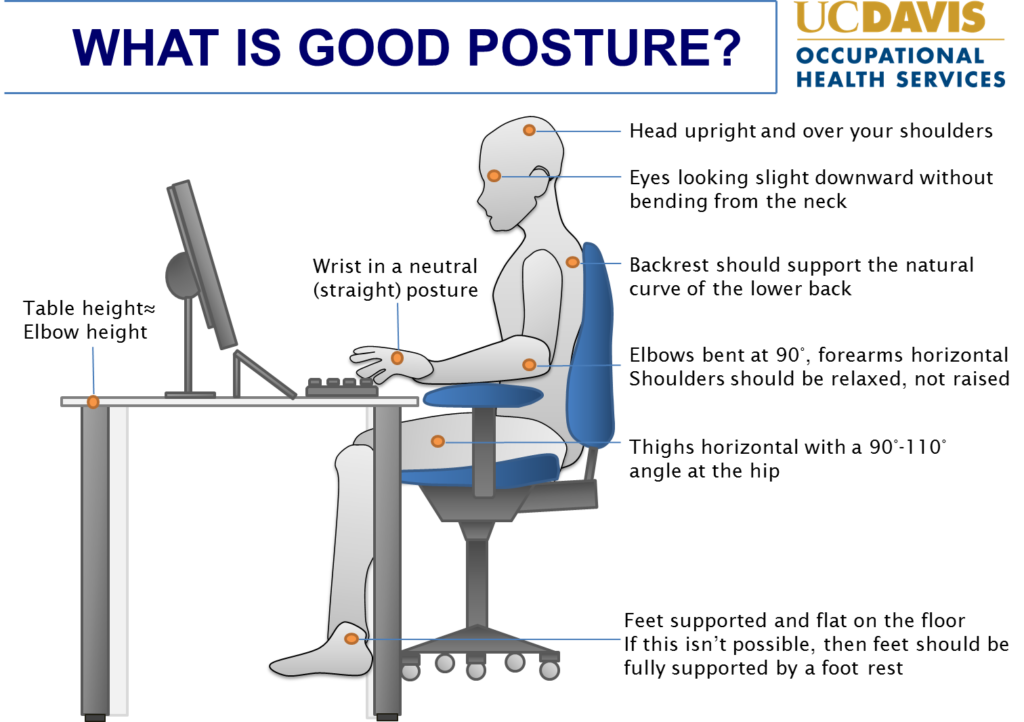
Design Philosophy of CA Office Design
We are always mindful that our Office or Cubicle Designs ensure the interaction of the human body with the surrounding environment, in order to achieve a balance between the workplace design and the human physical demands. By applying basic Ergonomic Design Principles, combined with the latest available Ergonomic Office Equipment, we aim to achieve the suitability of an Ergonomic Office Design to the varying needs of the employees that it facilitates.
Ergonomic Space Planning & Design not only forms a very important part of an Employer’s ADA Responsibility, but should also be an integral part of its Employment Strategy and in doing so, it will not only reduce your Workers Compensation Claims, but also improve Employee efficiency and create a happy work environment. To see how we can help you improve your ergonomic office environment in Southern California, please contact us for a free consultation.







